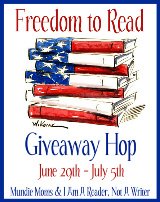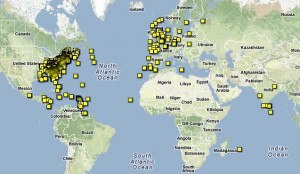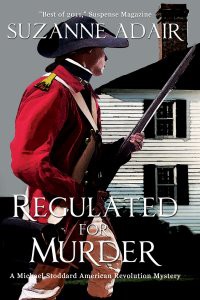 Welcome to my blog! The week of 29 June – 5 July, I’m participating with more than two hundred other bloggers in the “Freedom to Read” giveaway hop, accessed by clicking on the logo at the left. All blogs listed in this hop offer book-related giveaways, and we’re all linked, so you can easily hop from one giveaway to another. But here on my blog, I’m posting a week of Relevant History essays, each one focused on some facet of the American War of Independence. To find out how to qualify for the giveaways on my blog, read through each day’s Relevant History post below and follow the directions. Then click on the Freedom Hop logo so you can move along to another blog. Enjoy!
Welcome to my blog! The week of 29 June – 5 July, I’m participating with more than two hundred other bloggers in the “Freedom to Read” giveaway hop, accessed by clicking on the logo at the left. All blogs listed in this hop offer book-related giveaways, and we’re all linked, so you can easily hop from one giveaway to another. But here on my blog, I’m posting a week of Relevant History essays, each one focused on some facet of the American War of Independence. To find out how to qualify for the giveaways on my blog, read through each day’s Relevant History post below and follow the directions. Then click on the Freedom Hop logo so you can move along to another blog. Enjoy!
*****
 Some history teachers in high school impart upon their students the impression that the American War of Independence focused almost exclusively in the northernmost of King George the Third’s colonies in America. What perspective might those students have instead, if they saw this map, where each yellow square marks the location of a known altercation during the war? (Click on the image to enlarge it. The map was created by historian and cartographer John Robertson, whom I interviewed a few years ago. Indulge your inner history geek on John’s web site to learn details about each of those altercations.)
Some history teachers in high school impart upon their students the impression that the American War of Independence focused almost exclusively in the northernmost of King George the Third’s colonies in America. What perspective might those students have instead, if they saw this map, where each yellow square marks the location of a known altercation during the war? (Click on the image to enlarge it. The map was created by historian and cartographer John Robertson, whom I interviewed a few years ago. Indulge your inner history geek on John’s web site to learn details about each of those altercations.)
At first glance, it looks as though those teachers are justified to skew the history lessons. But exclude the area encompassed by the Northern theater—roughly New York, Pennsylvania, New Jersey, New Hampshire, Rhode Island, Connecticut, and Maine. Then consider how many yellow squares are left on the world map.
Subtracting the Northern theater puts but a small a dent in the quantity of yellow. From the spread and volume of the squares, it becomes clear that the lives of people living in the South, Midwest, Gulf Coast, Caribbean, and in Western Europe were also imperiled in this war.
What began as posturing and scuffling between Britain and her American colonies exploded into a war of international and naval significance: multiple powerful countries, multiple continents, multiple theaters. As with any far-reaching war, the economic shock waves rippled outward long after hostilities officially ceased.
Multiple powerful countries, multiple continents, multiple theaters. Do you think that qualifies the American War of Independence as a world war?
As I wrote last year, this is not your father’s Revolutionary War. We aren’t walking on the same turf that those history classes claim. In forthcoming essays from a diverse and stimulating group of historians, scholars, and artists, you’ll read about multiple theaters, viewpoints other than those of ardent patriots, and life lived despite war.
Welcome to the Second Annual Week-Long Fourth of July.
*****
 “Best of 2011!” says Suspense Magazine about my book Regulated for Murder: A Michael Stoddard American Revolution Thriller. Contribute a legitimate comment on this post by Saturday 30 June at 6 p.m. ET to be entered in a drawing to win one of two autographed copies of Regulated for Murder. Delivery is available worldwide. Make sure you include your email address. I’ll publish the names of all drawing winners on my blog the week of 9 July.
“Best of 2011!” says Suspense Magazine about my book Regulated for Murder: A Michael Stoddard American Revolution Thriller. Contribute a legitimate comment on this post by Saturday 30 June at 6 p.m. ET to be entered in a drawing to win one of two autographed copies of Regulated for Murder. Delivery is available worldwide. Make sure you include your email address. I’ll publish the names of all drawing winners on my blog the week of 9 July.
**********
Did you like what you read? Learn about downloads, discounts, and special offers from Relevant History authors and Suzanne Adair. Subscribe to Suzanne’s free newsletter.

When I was in school in the 60s and 70s, learning about the Revolutionary War was exactly as you described. It was all about the northern campaign with a throwaway comment about Yorktown. It was such that I was led to believe the war ended completely at Yorktown. Though what we did learn was interesting — we had Fort Mercer in our town, to which the school took us out to tour — it was incomplete. Even in 1976, the year I graduated from high school, when we had a more detailed emphasis on the war in school for the Bicentennial, it was still all about the north.
I went to school in Massachusetts and New Jersey, so perhaps that was why the emphasis was skewed — I’d be curious to find out how someone my age in NC or SC learned about the war. Perhaps there was more of a southern emphasis there.
I have to admit that it wasn’t until I saw the movie, the Patriot, that I was inspired to learn about the southern campaign. The movie, as inaccurate as it was, at least served as a springboard to learn the real story.
I met John Robertson in 2003 when he gave me and a friend visiting from another state a detailed tour of Cowpens, after which he patiently answered our questions in detail. A very nice guy who really knows his subject.
Hi Tracy, thanks for stopping by!
I grew up in Florida about the same time you did. Same experience in History class that you had. The Revolutionary War was all about the North. This was amazing, considering that Florida has St. Augustine, the oldest European settlement in the country, a major holding for the Crown of England during the War of Independence. We did learn a lot about the Spaniards, but Revolutionary War history in Florida and the South was bypassed in favor of Civil War history.
It wasn’t until the 1980s that I became interested in knowing more about what came before the Seminole Wars and Osceola. The more I read about Florida in the Revolution, the more annoyed I became. In the late 1990s, when I learned the importance of Georgia in the Revolution after a visit to St. Simon’s Island, I channeled my annoyance into writing books of adventure and mystery that would show the history.
Agree with your assessment of “The Patriot.” Wretchedly inaccurate, but at least the Revolutionary South finally got some attention.
John Robertson knows so much and is such a great fellow. It’s a joy to listen to him.
My history class did not even hint at the length of the conflict and how unlikely it was that the colonies would win.
I love things that suggest I ‘read further’ from a different perspective. Unfortunately, I am not even remotely a history buff. OTOH, SF alternate history stories appeal to me, and one that has captured my imagination is if Washington had won the battle of Montreal. The reason for this is my times on Prince Edward Island and all they tell you about how prosperous they were as a clearing house of trade going and coming from the colonies.
Thanks for that map.
Patg
Ah, Warren.
Length of conflict: officially 1775 – 1783. But unofficially? At least a decade before ’75, and at least through the War of 1812. After all, we bought that little piece of real estate from Napoleon, thus funding more aggression from Britain’s Enemy. Maybe your history class taught that the Revolutionary War ended in 1781, with Cornwallis’s surrender in Yorktown? Ha ha ha!
Likelihood of winning for the Continentals? Not very good. Remember that they’d set themselves up against a superpower with an awesome navy. The rebellion was almost over in 1777. Things improved a little when France entered the picture, and when Britain made her own bad luck with poor strategies that look remarkably like strategies employed right now.
Thanks for stopping by.
Welcome, Pat! John’s map rocks, doesn’t it?
I wasn’t a history buff, either, until I started researching it on my own. High-school history class makes us history-averse.
Those alternate history scenarios are fun! My favorite is: What if Pat Ferguson had squeezed the trigger at Brandywine while he had George Washington’s back in his sights and offed Washington? What high-ranking officer would have taken over as Commander in Chief after Washington? Benedict Arnold, maybe?
I wasn’t a history buff but as I got older I enjoy reading about it.
Welcome, Erma! I think plenty of people enjoy reading about history when they get older. We have to make a little history of our own before we can appreciate what happened before our lifetimes.
Well, how naive of me to think the Revolutionary War encompassed New York State and maybe a couple other northern states!! Ha! I was born and raised in upstate NY, so my history lessons were exclusive to NY. After all, one of my history projects was a replica of Fort Ticonderoga! But I was flabbergasted when I clicked on John’s map, saw those yellow dots and realized that there ‘is’ more to the Revolutionary War story.
Now that I can see from his map the war affected so many other parts of the world, it all makes sense. Having lived through a couple of wars in my lifetime, why did I not see that most of the world is affected during these times…no matter where you live, no matter what time period.
For me history came alive when I went to college in my mid-30s. That’s where I received my first “C” grade, in history, but my instructor told me that I’d be all right even though I considered the grade a blemish on my academic career. And you know, he was right. I’m doing fine and I love history and I write about those little-known events to keep history alive.
Thanks for sharing these Relevant History essays, Suzanne! I enjoyed reading this first post…
Thanks for commenting, Alice. Do you still have that replica of Ft. Ticonderoga? If I’d built something like that, I’d have kept it.

Most of us are such visual creatures that it takes an image like John’s map to drive home the point about this being an international war. You can see how widespread the misery was. It wasn’t just about us.
And I think an appreciation of history catches up with many of us as we get older.
Come back for more fun tomorrow.
It is gratifying that Suzanne and her recruits enjoy the graphical results of my obsession, but I must admit that I did all such for no more noble reason than to satisfy my own curiosity. In the map Suz showed you, there are included a *lot* of recent additions involving Native Americans in the South and those involved with Sullivan’s Expedition in the North (thanks to including the work of Elvin Birth, age 86). Those shown in the North are only for a one year period. There is much more left to be excavated from old county and regional histories in that region. This war remains much bigger than any existing analysis credits it for being.
On a serious note, I will turn 77 in a couple of weeks and am going strong, but I have been unable to recruit a younger sort with whom I could work along (teach all the tricks I’ve learned which are not neglible) and eventually turn over my Global Gazetteer (gaz.jrshelby.com) and my other site, Online Library of the Revolutionary War (lib.jrshelby.com). Any recruitment help for suitable candidates would be most welcome. If none are forthcoming, when I am gone, the lights will gradually start turning off.
Here he is, the man himself, John Robertson, Maker of the Yellow Squares! Thanks so much for stopping by. This map has been so helpful. I appreciate the “loan.”
What’s this…there are even more yellow squares to be added? That doesn’t surprise me. It may surprise a few folks living in the North, though.
And what’s this business about you being gone? You recently went parachuting for the first time. I saw the pictures. You liked it. Next thing we know, you’ll be parachuting onto little yellow squares.
This week I finished a 1961 compilation of letters of Benjamin Franklin, a very complex individual. I hadn’t really thought about his efforts at peace while in England. He came back in 1775 because of a death in his family and fighting broke out in Lexington and Concord while he was en route. Locally I was intriqued by a group of King’s Mtn reenactors who came to our community club. They were following the Victory Trail that patriots created thru western NC. Good stuff.
Hi Georgia! That story about Ben Franklin always makes me imagine the alternate-history scenario of text messaging capability in the 18th century. Ben’s having tea with a group of bewigged fellows in London when he gets the message: Take next ship back. Death in family. And while en route: Shots fired in Lexington & Concord. It’s war.
Franklin was, like Thomas Jefferson, a genius, with a diversity of interests and proficiencies. Imagine the sheer brainpower available to the French when Franklin, Jefferson, and John Adams were all there at the same time.
I think the Overmountain Men reenactors from several states recreate parts of the trail to Kings Mountain every year. What intrigued you about the presentation in your area?
I’m not a big fan of history, but I always try to read more about history. The book sounds interesting, so I would like to read it.